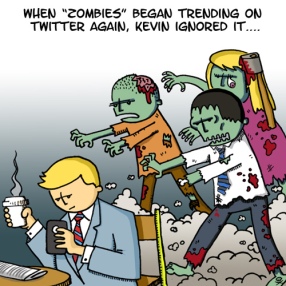In a new post series, First Steps Into Social will focus on specific industries and seek to provide some starting points for those new to (and perhaps overwhelmed by) the world of social media.
Setting up the platforms, such as a Facebook page or Twitter profile, is often the easiest part of stepping into social. The big challenge lies in creating regular, engaging content that will draw in your desired audience and build a community around your service or brand.
This series aims to offer some practical starting points that you can apply directly to your business, when we focus on your particular sector. With that in mind, please get in touch with me on Steve [at] RiseAboveTheStatic [dot] com if you want to bump your industry up the list for this series!
Note that these points are intended as thought starters rather than complete ‘how to’ guides (for that we’ll need to talk to you in much more detail and create a full strategy….let’s go!). Further discussion and new idea contributions are very much welcome and encouraged in the comments section, or on our Facebook page.
To kick things off, today we’ll take a look at some first steps a veterinary practice might take to move into social media content:
.
- Ask your clients if you can post pictures of their furry friends on Facebook. Even better, encourage them to ‘Like’ your page and post their own pictures, building your community and engaging them by showing off their loved one(s). Focus on praising the pet and wanting to highlight/share their special qualities with others, much as our clients at Big Creek Pet Hospital are doing on their BCPH Facebook page.
- Provide health alerts, product recall details, current items of news, and other information that you believe would be of value to your existing and potential clients. The American Veterinary Medical Association‘s Facebook group is a great example of providing an outstanding information resource. You may choose yours to be more locally focused, treatment-based, or whatever mix you feel is most relevant for your audience.
- Use a blog or Facebook note to provide specific stories about patients, staff, or other areas of practice itself. Give readers an insight into the caring, professional environment your facility offers. This could also be achieved in the form of a tour, using pictures and/or video to highlight the quality of care. Olathe Animal Hospital in Kansas is a wonderful example of a veterinary practice providing a regular glimpse into their daily life via Facebook.
- Write more detailed pieces on a blog about current pet health issues, recommended treatments, seasonal concerns etc. As we highlighted in 7 Ways to Prove You’re The Expert’s Expert, this gives an opportunity to demonstrate your knowledge on topical subjects in your field, at the same time as drawing attention to crucial issues of the moment. As summer arrives, for example, many pet health writers are focusing on tips for keeping dogs and cats safe in the hot weather, such as this piece from the ASPCA.
- Create video content for areas that are more suited to visual learning, such as methods for training a dog to learn a new behavior. Sites like YouTube and Vimeo, as well as cheap video cameras and production software, now make video production an achievable goal for almost anyone. It also adds an extra dimension to your content, which can then be shared across other platforms and even embedded as a part of your own website. Specialist dog training company Hand In Paw has a great series of videos on their YouTube site, as well as another excellent example from Big Creek Pet Hospital in this guide to brushing your pet’s teeth.
.
As with all social media content, success lies in providing an alluring blend of topical pet health information and fun interaction with those who have the cute furry family members we hold so dear.
The beauty of social media in the pet world is that owners are often so enthusiastic to share the wonders of their dog, cat, or other loved one, that all it takes is a nudge from you to ask them to do so. So, as their dedicated pet carer, why not try to come up with creative ways to allow people to let others enjoy their pets as much as they do….almost!
.
Pet health professionals, what tips would you suggest for others trying to offer valued, entertaining content through social media? What successes have you had that you can share?
Pet owners, how can your veterinarian do more for you by providing web resources and communicating with you online? What do you need from them?
Photo courtesy of ValP




 Posted by Steve Birkett
Posted by Steve Birkett 








